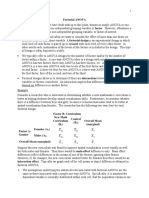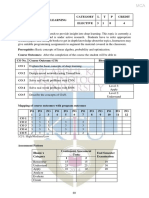0 ratings0% found this document useful (0 votes)
13 viewsProbability Notes
A probability distribution defines the probabilities of all possible outcomes of a random experiment or variable. It can take the form of a table or equation relating each outcome to its probability of occurrence. There are two main types of probability distributions: continuous/normal distributions where outcomes can be any value in a range, and discrete/binomial distributions where outcomes are discrete values. Common examples include the normal distribution for natural phenomena like temperature, and the binomial distribution for counting experiments like coin flips.
Uploaded by
Shanmugaprabha SCopyright
© © All Rights Reserved
Available Formats
Download as DOCX, PDF, TXT or read online on Scribd
0 ratings0% found this document useful (0 votes)
13 viewsProbability Notes
A probability distribution defines the probabilities of all possible outcomes of a random experiment or variable. It can take the form of a table or equation relating each outcome to its probability of occurrence. There are two main types of probability distributions: continuous/normal distributions where outcomes can be any value in a range, and discrete/binomial distributions where outcomes are discrete values. Common examples include the normal distribution for natural phenomena like temperature, and the binomial distribution for counting experiments like coin flips.
Uploaded by
Shanmugaprabha SCopyright
© © All Rights Reserved
Available Formats
Download as DOCX, PDF, TXT or read online on Scribd
You are on page 1/ 7
What is the Probability Distribution?
In the field of Statistics, Probability Distribution plays a major role in giving
out the possibility of every outcome pertaining to a random experiment or
event. It gives forth the probabilities of various possible occurrences. One is
already aware that Probability refers to the measure of the uncertainties
found in different phenomenon’s.
A Probability Distribution is a table or an equation that interconnects each
outcome of a statistical experiment with its probability of occurrence.
To understand the concept of a Probability Distribution, it is important to
know variables, random variables, and some other notations.
Random experiments are often defined to be the result of an experiment
whose result is hard to predict. For instance, while flipping a coin, one cannot
predict the outcome, that is, whether it will be a head or a tail. The possible
result witnessed in a random experiment is termed as its outcome. While the
set of outcomes is referred to as the sample point. With reference to these
experiments or events, one can easily create a Probability table in terms of
the expected variables and probabilities.
Variables: A variable is defined as any symbol that can take any particular
set of values.
Random Variable: When the value of any variable is the outcome of a
statistical experiment, that variable is determined as a Probability
Distribution of random variables. It can be Discrete (not constant) or
Continuous or both.
Mostly, statisticians make use of capital letters to denote a Probability
Distribution of random variables and small-case letters to represent any of
its values.
X denotes the Probability Distribution of random variable X
P(X) denotes the Probability of X.
p( X=x) denotes the Probability that random variable x is equivalent to any
particular value, represented by X. For example: P (X=1) states the Probability
Distribution of the random variable X is equivalent to 1.
Probability Distribution of Random Variables
A random variable is said to have a Probability Distribution that goes on to
define the Probability of its unknown values. These random variables can
often be Discrete and at other times Continuous, or even both. This refers to
the fact that it will take any designated finite or countable values along with a
Probability mass Function of the given random variable’s Probability
Distribution. It can also take up any numerical value in any given interval or
even set of intervals.
Any two random variables possessing equal Probability Distribution can still
vary due to their relationship with other random variables. Random variates
is a term used to describe the recognition of the random variable.
Probability Distribution Definition
Probability Distributions give up the possible outcome of any random event.
It is also identified on the grounds of underlying sample space as a set of
possible outcomes of any random experiment. These settings can be a set of
Prime Numbers, a set of Real Numbers, a set of Complex Numbers, or a set
of any entities. The Probability Distribution is a part of Probability and
Statistics.
Random experiments are termed as the outcomes of an experiment whose
results cannot be predicted. For example- if we toss a coin, we cannot predict
what will appear, either the head or tail. The possible result of a random
experiment is known as the outcome. And the set of outcomes is termed as a
sample point. Through these possibilities, we can design a Probability table
on the basis of variables and probabilities.
Types of Probability Distribution:
There are two types of Probability Distribution which are used for distinct
purposes and various types of data generation processes.
These Two Types of Probability Distribution are:
1. Normal or Continuous Probability Distribution
2. Binomial or Discrete Probability Distribution
Normal Probability Distribution
In this Distribution, the set of all possible outcomes can take their values on a
continuous range. It is also known as Continuous or cumulative Probability
Distribution.
For example- Set of real Numbers, set of prime numbers, are the Normal
Distribution examples as they provide all possible outcomes of real Numbers
and Prime Numbers. Real-life scenarios such as the temperature of a day is
an example of Continuous Distribution.
As the Normal Distribution Statistics predict some natural events clearly, it
has developed a standard of recommendation for many Probability issues.
Some examples are:
Rolling of a dice
Tossing a coin
Height of a newly born babies
Size of men or women's shoes.
Income Distribution of a country between rich and poor
Binomial / Discrete Probability Distribution
The Binomial Distribution is also termed as a Discrete Probability Function
where the set of outcomes is Discrete in nature. For example: if a dice is
rolled, then all its possible outcomes will be Discrete in nature and it gives
the mass of outcome. It is also considered a Probability mass Function
In a real-life scenario the concept of Binomial Distribution is used for:
To find out the number of men and women working in a college
To find the Number of used and unused particles while manufacturing
a product
To check the Number of people watching the particular channel by
calculating the or yes or no.
To take a survey of positive and negative feedback for some issues.
Negative Binomial Distribution
A negative Binomial Distribution is a term used when in a given Discrete
Probability Distribution, before a particularized Number of failures occurs,
the Number of the success in the series of the independent and identical
Bernoulli trials happens. The Number of failures here is denoted by the letter
‘r’. For example, while throwing a dice, we determine the occurrence of the
Number 1 as a failure and all the mom-1’s as a success. Now, throwing the
dice Continuously until the Number 1 occurs three times, indicating three
failures, in this case, the Probability Distribution of the non-1 Numbers that
have arrived would be referred to as the Negative Binomial Distribution.
Poisson Probability Distribution
This Discrete Probability Distribution presents the Probability of a given
number of events that occur in time and space, at a steady rate. It had
gained its name from the French Mathematician Simeon Denis Poisson. This
kind of Distribution also finds its relevance in other events occurring at
particular intervals, for example, distance, area, and volume. Some examples
of these are;
Number of patients arriving at the hospital in the time interval 10 to 11
AM
Number of emails that a manager receives in the office hours.
PRIOR Probability
Prior Probability, also known as prior, of a quantity that is unpredictable,
refers to the Probability Distribution which expresses one’s faith in the given
quantity before any given proof is taken into records. For example, the prior
Probability Distribution points at the relative proportions of voters that might
vote for a given politician at the election. The hidden quantity can point at
the possible variable rather than at a perceptible variable.
You might also like
- Jeff Augen - Trading Options at Expiration-Strategies and Models For Winning The Endgame100% (1)Jeff Augen - Trading Options at Expiration-Strategies and Models For Winning The Endgame6 pages
- Lesson 3-Discreet Probability DistributionsNo ratings yetLesson 3-Discreet Probability Distributions13 pages
- Statistics and Probability Second SEMESTER S.Y. 2020 - 2021: QuestNo ratings yetStatistics and Probability Second SEMESTER S.Y. 2020 - 2021: Quest6 pages
- Engineering Data Analysis Chapter 3 - Discrete Probability DistributionNo ratings yetEngineering Data Analysis Chapter 3 - Discrete Probability Distribution18 pages
- 4 Probability Theory and Probability DistributionNo ratings yet4 Probability Theory and Probability Distribution52 pages
- httpscdn.fbsbx.comvt59.2708-21417172328_1042234447002868_534542395353161222_n.pdfIntroduction-final.pdf_nc_cat=103&ccb=1No ratings yethttpscdn.fbsbx.comvt59.2708-21417172328_1042234447002868_534542395353161222_n.pdfIntroduction-final.pdf_nc_cat=103&ccb=153 pages
- Module 2 in IStat 1 Probability DistributionNo ratings yetModule 2 in IStat 1 Probability Distribution6 pages
- Some Probability Distributions: Marnielle A. Salig LecturerNo ratings yetSome Probability Distributions: Marnielle A. Salig Lecturer59 pages
- Understanding The Concepts of ProbabilityNo ratings yetUnderstanding The Concepts of Probability10 pages
- A Practical Overview On Comparison Discrete and Continuous Probability DistributionsNo ratings yetA Practical Overview On Comparison Discrete and Continuous Probability Distributions4 pages
- Lecture 4 - Probability and Normal DistributionNo ratings yetLecture 4 - Probability and Normal Distribution42 pages
- statatics and probability chapter 3 and 4No ratings yetstatatics and probability chapter 3 and 410 pages
- 05 Descriptive Statistics - DistributionNo ratings yet05 Descriptive Statistics - Distribution5 pages
- Probability Distributions: Values That The Random Variable Can Take On. Thus, The Expression P (X X) Symbolizes TheNo ratings yetProbability Distributions: Values That The Random Variable Can Take On. Thus, The Expression P (X X) Symbolizes The6 pages
- Reflective Essay of Probability StatisticsNo ratings yetReflective Essay of Probability Statistics24 pages
- Probability Distribution: Question BookletNo ratings yetProbability Distribution: Question Booklet8 pages
- Chapter 3 Discrete Probability DistributionNo ratings yetChapter 3 Discrete Probability Distribution34 pages
- Chapter-6-Random Variables & Probability DistributionsNo ratings yetChapter-6-Random Variables & Probability Distributions13 pages
- The Locomotion of The Cockroach Periplaneta AmericanaNo ratings yetThe Locomotion of The Cockroach Periplaneta Americana10 pages
- A Study On Investors Perception Towards Commodity Futures With Special Reference To Unique Trading Solutions LTD, CoimbatoreNo ratings yetA Study On Investors Perception Towards Commodity Futures With Special Reference To Unique Trading Solutions LTD, Coimbatore11 pages
- DISS Q1 M2 Social Science As Scientific Study of Society100% (1)DISS Q1 M2 Social Science As Scientific Study of Society23 pages
- Assignment Instructions For The Data Analytics ReportNo ratings yetAssignment Instructions For The Data Analytics Report5 pages
- Business Inferential Statistics Course OutlineNo ratings yetBusiness Inferential Statistics Course Outline3 pages
- Algorithms: CSE 202 - Homework III: J J J J J JNo ratings yetAlgorithms: CSE 202 - Homework III: J J J J J J4 pages
- Clinical Assessment, Diagnosis, and Research Methods100% (1)Clinical Assessment, Diagnosis, and Research Methods53 pages
- Multiple Regression Analysis, The Problem of EstimationNo ratings yetMultiple Regression Analysis, The Problem of Estimation53 pages
- Jeff Augen - Trading Options at Expiration-Strategies and Models For Winning The EndgameJeff Augen - Trading Options at Expiration-Strategies and Models For Winning The Endgame
- Statistics and Probability Second SEMESTER S.Y. 2020 - 2021: QuestStatistics and Probability Second SEMESTER S.Y. 2020 - 2021: Quest
- Engineering Data Analysis Chapter 3 - Discrete Probability DistributionEngineering Data Analysis Chapter 3 - Discrete Probability Distribution
- httpscdn.fbsbx.comvt59.2708-21417172328_1042234447002868_534542395353161222_n.pdfIntroduction-final.pdf_nc_cat=103&ccb=1httpscdn.fbsbx.comvt59.2708-21417172328_1042234447002868_534542395353161222_n.pdfIntroduction-final.pdf_nc_cat=103&ccb=1
- Some Probability Distributions: Marnielle A. Salig LecturerSome Probability Distributions: Marnielle A. Salig Lecturer
- A Practical Overview On Comparison Discrete and Continuous Probability DistributionsA Practical Overview On Comparison Discrete and Continuous Probability Distributions
- Probability Distributions: Values That The Random Variable Can Take On. Thus, The Expression P (X X) Symbolizes TheProbability Distributions: Values That The Random Variable Can Take On. Thus, The Expression P (X X) Symbolizes The
- Chapter-6-Random Variables & Probability DistributionsChapter-6-Random Variables & Probability Distributions
- The Locomotion of The Cockroach Periplaneta AmericanaThe Locomotion of The Cockroach Periplaneta Americana
- A Study On Investors Perception Towards Commodity Futures With Special Reference To Unique Trading Solutions LTD, CoimbatoreA Study On Investors Perception Towards Commodity Futures With Special Reference To Unique Trading Solutions LTD, Coimbatore
- DISS Q1 M2 Social Science As Scientific Study of SocietyDISS Q1 M2 Social Science As Scientific Study of Society
- Assignment Instructions For The Data Analytics ReportAssignment Instructions For The Data Analytics Report
- Clinical Assessment, Diagnosis, and Research MethodsClinical Assessment, Diagnosis, and Research Methods
- Multiple Regression Analysis, The Problem of EstimationMultiple Regression Analysis, The Problem of Estimation

























































































